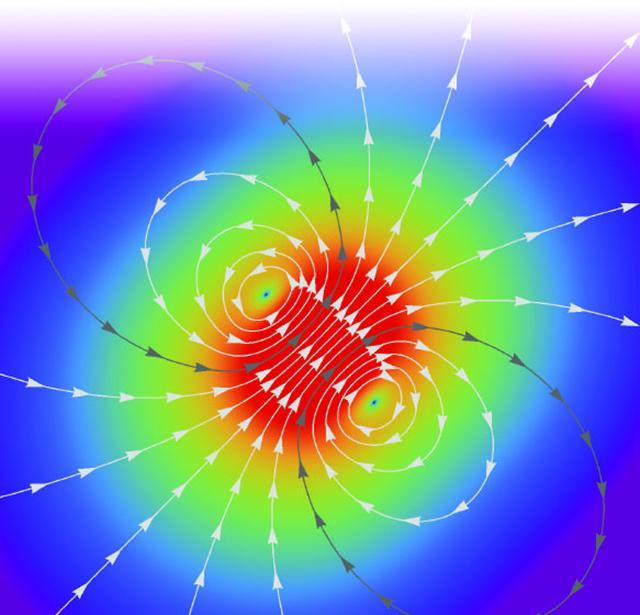Researchers propose technique for measuring weak or nonexistent magnetic fields

A proposed diamond probe stimulates magnetic moments (aligned electrons) in the material being studied, which then act upon the magnetic field of the probe itself and thus can be measured. Credit: Michael Flatte, University of Iowa
Physicists at the University of Iowa have proposed a new technique to detect and measure materials that give off weak magnetic signals or have no magnetic field at all. Their solution would use a noninvasive probe to induce a magnetic response in the material being studied and then detect how that response changes the probe's own magnetic field.
The technique has many potential real-world applications, including yielding more sensitive magnetic resonance imaging (MRI) machines, developing high-speed-storage memory in the semiconducting industry, and producing more efficient computer processing units (CPUs).
“This approach is designed to measure the situation where if you didn't have the probe nearby, you'd see nothing. There wouldn't be any magnetic fields at all,” says Michael Flatté, physics and astronomy professor and senior author of the paper published in the journal Physical Review Letters. “It's only the probe itself that's causing the presence of the magnetic fields.”
The probe does this by creating “magnetic moments” in materials that otherwise would emit a weak magnetic field or have no magnetic field at all. Magnetic moments occur when a group of electrons orient themselves in the same direction, much like tiny compass needles all pointing, say, north.
That uniform orientation creates a tiny magnetic field. Iron, for example, produces a strong response because most of its electrons get oriented in the same direction when it encounters a magnetic force.
All it takes for the probe, which is just a few nanomaters in diameter, to create a magnetic moment is for two of its six electrons to snap to the same directional orientation. When that happens, the probe stimulates enough electrons in materials with weak or nonexistent magnetic fields to re-orient themselves, creating a magnetic moment in the material–or just enough of one–that the probe can detect. How the material's magnetic moment influences the probe's own magnetic field is measurable, which gives researchers the means to calculate the material's physical dimensions, such as its thickness.
“These electrons (in materials with weak or nonexistent magnetic fields) have their own field that acts back on the probe and distorts the probe (in a way) that you can then measure,” says Flatté, director of the UI's Optical Science Technology Center.
This becomes important when trying to capture the dimensions of magnetic layers that are buried or sandwiched between nonmagnetic layers. Such situations arise when working with semiconductors and will increase as computer processing advances.
“We calculate the magnetic response, and from that we would know where the magnetic fields end and thus know the layer thickness,” Flatté says.
The concept builds upon an emerging sampling approach called nitrogen-vacancy center magnetometry. This technique, which relies upon an introduced defect in a diamond's crystal structure (subbing in a nitrogen atom for two carbon atoms), is effective in part because the probe it uses (like the proposed UI probe) is made of diamond, which creates small magnetic moments key to detecting magnetic fields in the studied materials.
But there is a drawback: Nitrogen-vacancy center magnetometry only works with magnetized materials. That rules out superconductors, where the magnetic field ceases to exist at certain temperatures, and many other materials. Flatté and co-author Joost van Bree's proposed solution gets around that by using the probe to create a magnetic field that forces materials with weak or nonexistent magnetic fields to react to it.
“If you apply a magnetic field to a superconductor, it will attempt to cancel that magnetic field applied to it,” Flatté says. “Even though it's doing that, it creates a magnetic field outside of itself that then affects the spin centers. That's what then can be detected.”
###
The U.S. Air Force's Office of Scientific Research, through a Multidisciplinary University Research Initiative grant to Flatté, funded the research.
Media Contact
All latest news from the category: Physics and Astronomy
This area deals with the fundamental laws and building blocks of nature and how they interact, the properties and the behavior of matter, and research into space and time and their structures.
innovations-report provides in-depth reports and articles on subjects such as astrophysics, laser technologies, nuclear, quantum, particle and solid-state physics, nanotechnologies, planetary research and findings (Mars, Venus) and developments related to the Hubble Telescope.
Newest articles

NASA: Mystery of life’s handedness deepens
The mystery of why life uses molecules with specific orientations has deepened with a NASA-funded discovery that RNA — a key molecule thought to have potentially held the instructions for…

What are the effects of historic lithium mining on water quality?
Study reveals low levels of common contaminants but high levels of other elements in waters associated with an abandoned lithium mine. Lithium ore and mining waste from a historic lithium…

Quantum-inspired design boosts efficiency of heat-to-electricity conversion
Rice engineers take unconventional route to improving thermophotovoltaic systems. Researchers at Rice University have found a new way to improve a key element of thermophotovoltaic (TPV) systems, which convert heat…



